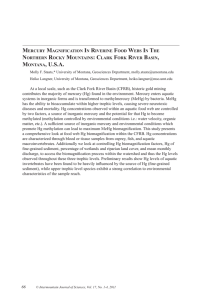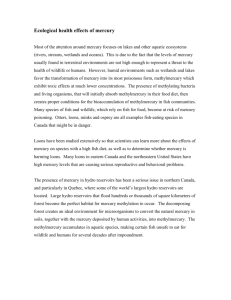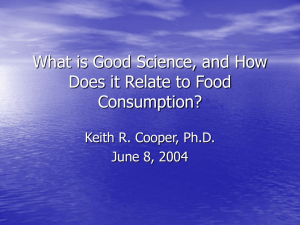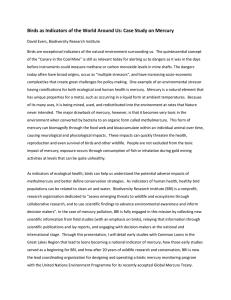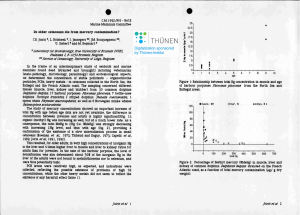Methylmercury - Canadian Environmental Quality Guidelines
advertisement
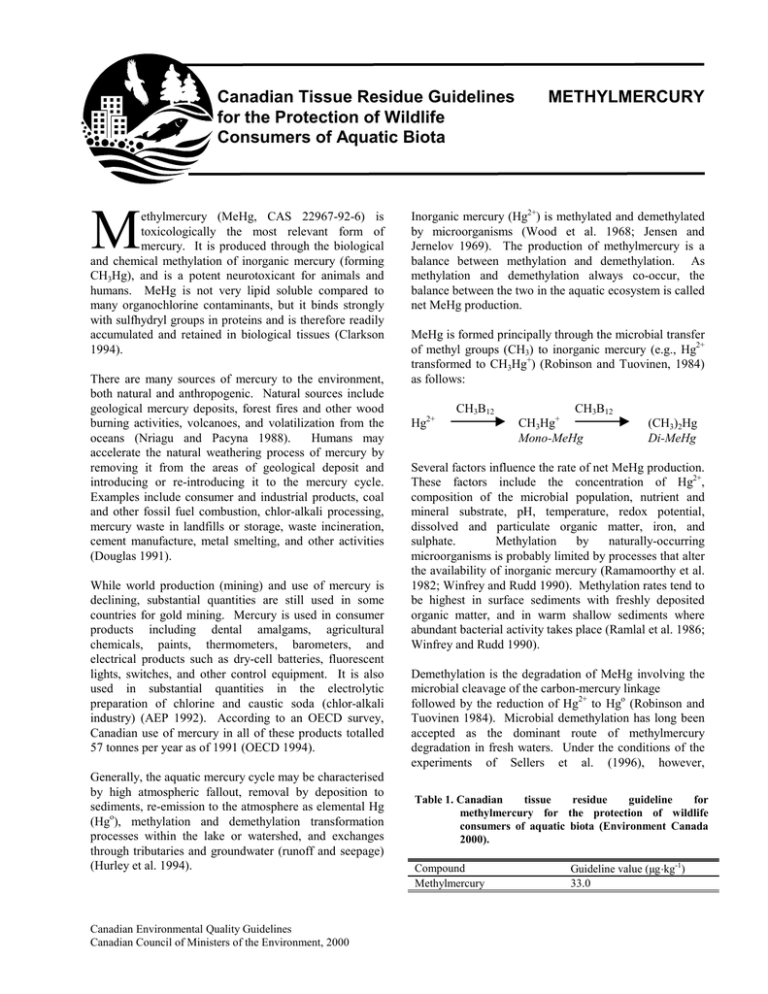
Canadian Tissue Residue Guidelines for the Protection of Wildlife Consumers of Aquatic Biota M ethylmercury (MeHg, CAS 22967-92-6) is toxicologically the most relevant form of mercury. It is produced through the biological and chemical methylation of inorganic mercury (forming CH3Hg), and is a potent neurotoxicant for animals and humans. MeHg is not very lipid soluble compared to many organochlorine contaminants, but it binds strongly with sulfhydryl groups in proteins and is therefore readily accumulated and retained in biological tissues (Clarkson 1994). There are many sources of mercury to the environment, both natural and anthropogenic. Natural sources include geological mercury deposits, forest fires and other wood burning activities, volcanoes, and volatilization from the oceans (Nriagu and Pacyna 1988). Humans may accelerate the natural weathering process of mercury by removing it from the areas of geological deposit and introducing or re-introducing it to the mercury cycle. Examples include consumer and industrial products, coal and other fossil fuel combustion, chlor-alkali processing, mercury waste in landfills or storage, waste incineration, cement manufacture, metal smelting, and other activities (Douglas 1991). While world production (mining) and use of mercury is declining, substantial quantities are still used in some countries for gold mining. Mercury is used in consumer products including dental amalgams, agricultural chemicals, paints, thermometers, barometers, and electrical products such as dry-cell batteries, fluorescent lights, switches, and other control equipment. It is also used in substantial quantities in the electrolytic preparation of chlorine and caustic soda (chlor-alkali industry) (AEP 1992). According to an OECD survey, Canadian use of mercury in all of these products totalled 57 tonnes per year as of 1991 (OECD 1994). Generally, the aquatic mercury cycle may be characterised by high atmospheric fallout, removal by deposition to sediments, re-emission to the atmosphere as elemental Hg (Hgo), methylation and demethylation transformation processes within the lake or watershed, and exchanges through tributaries and groundwater (runoff and seepage) (Hurley et al. 1994). Canadian Environmental Quality Guidelines Canadian Council of Ministers of the Environment, 2000 METHYLMERCURY Inorganic mercury (Hg2+) is methylated and demethylated by microorganisms (Wood et al. 1968; Jensen and Jernelov 1969). The production of methylmercury is a balance between methylation and demethylation. As methylation and demethylation always co-occur, the balance between the two in the aquatic ecosystem is called net MeHg production. MeHg is formed principally through the microbial transfer of methyl groups (CH3) to inorganic mercury (e.g., Hg2+ transformed to CH3Hg+) (Robinson and Tuovinen, 1984) as follows: Hg2+ CH3B12 CH3B12 CH3Hg+ Mono-MeHg (CH3)2Hg Di-MeHg Several factors influence the rate of net MeHg production. These factors include the concentration of Hg2+, composition of the microbial population, nutrient and mineral substrate, pH, temperature, redox potential, dissolved and particulate organic matter, iron, and sulphate. Methylation by naturally-occurring microorganisms is probably limited by processes that alter the availability of inorganic mercury (Ramamoorthy et al. 1982; Winfrey and Rudd 1990). Methylation rates tend to be highest in surface sediments with freshly deposited organic matter, and in warm shallow sediments where abundant bacterial activity takes place (Ramlal et al. 1986; Winfrey and Rudd 1990). Demethylation is the degradation of MeHg involving the microbial cleavage of the carbon-mercury linkage followed by the reduction of Hg2+ to Hgo (Robinson and Tuovinen 1984). Microbial demethylation has long been accepted as the dominant route of methylmercury degradation in fresh waters. Under the conditions of the experiments of Sellers et al. (1996), however, Table 1. Canadian tissue residue guideline for methylmercury for the protection of wildlife consumers of aquatic biota (Environment Canada 2000). Compound Methylmercury Guideline value (µg⋅kg-1) 33.0 METHYLMERCURY Canadian Tissue Residue Guidelines for the Protection of Wildlife Consumers of Aquatic Biota photodegradation of MeHg was about 350 times greater than microbial demethylation. These results suggest that MeHg degradation may be an important process where light penetration is significant (such as in clear and/or shallow water). availability for methylation. The Hg-Se ratio has shown a tendency to be higher in freshwater fish than in marine fish, which may reflect the higher relative mercury levels in certain freshwater environments (Pelletier 1985). Some lakes are more prone to MeHg contamination than others. These include hydroelectric reservoirs (Abernathy and Cumbie 1977; Lodenius et al 1983; Stokes and Wren 1987; Jackson 1988; Hecky et al. 1991); low pH lakes (Wren and MacCrimmon 1983; Verta et al. 1986; McMurtry et al. 1989); and even some remote lakes with no apparent other stressors associated with high mercury. The explanation for high MeHg in fish from these lakes is different in each case, but usually relates to factors affecting net MeHg production and transfer to the food web. In the case of newly formed reservoirs, the flooding of fresh vegetation and subsequent high bacterial activity causes mercury methylation to increase substantially (Ramlal et al. 1987; Hecky et al. 1991). The elevated MeHg in reservoir fish may decline in a few years or may remain elevated for decades (Bodaly et al. 1984). With respect to animal uptake, about 95% of an ingested dose of MeHg is absorbed into the bloodstream from the gastrointestinal tract, whereas inorganic Hg is less efficiently absorbed (7 to 15%; Wolfe et al. 1998). MeHg distributes via the bloodstream to all parts of the body, readily crosses placental barriers, may enter the fetal brain, and is readily accumulated in growing animal fur, bird feathers, or human hair. The accumulation of mercury in the brain is greater in mammals than in fish (Zillioux et al. 1993). Many countries have mercury or MeHg guidelines to protect human consumers of fish and shellfish. Only the United States and Canada, however, are in the process of establishing guidelines to protect wildlife that consume fish and other aquatic biota. The US EPA “Mercury Report to Congress” is a series of comprehensive reviews of all aspects of mercury and MeHg in the environment, including the derivation of water concentrations and tolerable consumption levels to protect wildlife consumers of fish Recommended water concentrations of 50 pg MeHg⋅L-1 and 641 pg THg⋅L-1are intended to protect avian wildlife from ingesting more than the safe daily dosage, or Reference Dose (RfD) of 21 µg⋅kg-1 bw per day and to protect semi-aquatic mammals from ingesting more than 18 µg⋅kg-1 bw per day.(USEPA 1997a,b). MeHg has a high potential for bioaccumulation as well as biomagnification with increasing trophic levels. Inorganic mercury and MeHg may be taken up by aquatic organisms directly from water or through their diet. Uptake by aquatic animals directly from water is the result of dissolved mercury adsorption or absorption through the body surface and respiratory organs such as gills. The proportion of MeHg relative to total Hg (THg) increases through the food web, being lowest in aquatic plants, intermediate in invertebrates, and highest in fish, piscivorous mammals, and birds (USEPA 1997a,b). The Canadian Tissue Residue Guideline for the protection of wildlife consumers of aquatic biota is reported in Table 1. Table 2 provides examples of MeHg measurements made in Canadian biota. The data represent typically low and high levels of MeHg measured in various organisms collected from Canadian waters, with the exception of marine fish, where few data were available. Fish, piscivorous mammals, and birds accumulate most of their mercury body burdens through their diet. Mercury in fish is comprised almost exclusively of MeHg regardless of the composition of diet sources and exposure water (Rodgers 1994). MeHg levels in wildlife consumers of fish are elevated relative to the fish or other aquatic biota they consume indicating its biomagnification potential. Toxicity Selenium (Se) is believed to reduce the accumulation of mercury while sulphur may impede the formation of MeHg. For example, Se was hypothesized to be one factor that reduced MeHg accumulation after the unexpected finding of low mercury in the tissues of mink and otter near Sudbury compared to other locations in Ontario (Wren and Stokes 1988). The solubility products (Ks) of HgSe and HgS are 10-58 and 10-52, respectively (WHO 1990), which would indicate a strong binding of mercury ions and a reduction of Methylmercury is more toxic than other forms of mercury as it can pass through the blood-brain barrier and nuclear membranes to react directly with cellular components (Sloss 1995). MeHg is a strong neurotoxicant in that it damages or destroys nerve tissue of most vertebrates because they lack external barriers and substantial internal detoxifying systems. Specifically, the central nervous system (i.e., that portion of the vertebrate nervous system 2 Canadian Tissue Residue Guidelines for the Protection of Wildlife Consumers of Aquatic Biota METHYLMERCURY consisting of the brain and spinal cord) is very sensitive to MeHg exposure. observed at 0.76 mg·kg-1 (46 µg·kg -1 bw per day). The NOAEL was 0.3 mg·kg-1 (20 µg⋅kg-1 bw per day) (Charbonneau et al. 1976). Periodic monitoring of the diet indicated that MeHg accounted for 95% of THg. Groups of male Wistar rats were the most sensitive to MeHg because an intake rate of 25 µg·kg -1 bw per day resulted in ataxia and hind limb paralysis after six months exposure to a contaminated non-fish diet (nominal concentrations used) (Munro et al. 1980). Many neurological effects are ecologically relevant and may include ataxia, staggering, paralysis in the hind limbs, and anorexia. These effects and others were reported in many of the studies that described neurotoxicity resulting from MeHg exposure. Such effects would render an animal unable to properly feed, escape from predators, reproduce, and would ultimately increase their susceptibility to other environmental stressors. MeHg has not been irrefutably implicated as a carcinogen, and is not considered a mutagen (WHO 1990). The toxic effects of MeHg have been known to decrease with concurrent Se exposure (reviewed in Cuvin-Aralar and Furness 1991), although Se itself may be toxic at elevated concentrations. Within vertebrates, there may be a biologically-derived protection against MeHg toxicity because selenium restores the activities of certain liver enzymes, and glutathione status involved in antioxidative defense mechanisms (Heinz and Hoffman 1998). Mammalian Toxicity Neurotoxicological damage was observed in domestic cats (Felis catus) fed northern pike (Esox lucius) contaminated with 1.2 mg·kg-1 of THg (74 µg⋅kg-1 bw per day) over a two year period. Subtle neurological deficits were Of wildlife species, mink (Mustela vison) are known to be sensitive to mercury exposure. Greater than 50% of female mink fed natural fish diets containing 0.9 mg·kg-1 of MeHg died with signs of neurotoxicity within 80 to 101 days (Chamberland et al. 1996). This dietary concentration corresponds to a daily intake rate of 144 µg·kg-1 bw per day assuming a food intake to body weight ratio of 0.16 for captive female mink (Bleavins and Aulerich 1981). Mink consuming 16 or 80 µg·kg-1 bw per day displayed no clinical signs, neurological damage or reproductive effects (Chamberland et al. 1996; Laperle et al. 1998). The authors reported no confounding effects of other contaminants in the fish diet. Similarly, Wren et al. (1987) reported a lethal MeHg dosage for mink of 1 mg·kg-1. This dietary concentration is converted to 180 and 100 µg·kg -1 bw per day for females and males, respectively, using average mink body weights and daily food rations (Wren et al. 1987a). When the treatment was changed such that mink were fed the contaminated diet every other day, the only sublethal effect was that kits were born with a high mercury burden, which decreased by five weeks of age (Wren et al. 1987a,b). In another Table 2. Levels (µg·kg ) of Total mercury (THg) and Methylmercury (MeHg) and percent MeHg in select Canadian biota. Biota Tissue Year Total Hg MeHg Reference µg·kg-1(ww)a µg·kg-1 (%) Macrophytes Freshwater Whole 1992 6 000-18 800 1 300-6 400 (37%) Moore et al. 1995 (dw) Sphagnum spp. Freshwater Whole 1992 36 000-93 000 500-20 000 Moore et al. 1995 (dw) (2-19%) Invertebrates Freshwater Whole 1992 400 (dw) 160 (44%) Malley et al. 1996 Freshwater Whole 1992 120-1 680 (dw) 14-1 520 Tremblay et al. 1996 (6-100%) Fish Freshwater Muscle 1978+ 130-2 200 (~100%) Bodaly et al. 1984 Marine Whole 1981 5-15 -Braune 1987 Amphibians Freshwater Whole 1990+ 90-290 -Bonin et al. 1995 Mammals Marine Liver Var 10 000-34 000 4 600-7 3000b Wagemann 1995, 1996; (<30%) Langlois et al. 1995 Freshwater Liver 1983-85 7 500 4 000 (53%) Wren et al. 1986 Freshwater Kidney 1983-85 5 500 2 400 (43%) Wren et al. 1986 Freshwater Muscle 1983-90 300-2 400 -Wren et al. 1986; Langlois et al. 1995 Birds Freshwater Eggs 1974-75 540-1 400 530-1 400 Barr 1986 (97-99%) Freshwater Muscle 1971 160-19 400 110-17 800 Vermeer et al. 1973 (69-99%) Marine Muscle 1978-84 370-610 3 -Braune 1987 -1 a ww = wet wt, unless indicated as dw = dry wt. b MeHg not measured on all samples. METHYLMERCURY Canadian Tissue Residue Guidelines for the Protection of Wildlife Consumers of Aquatic Biota study, mink consuming MeHg at a rate of 176 µg·kg -1 bw per day (1.1 mg·kg-1 diet) survived, however, histopathological abnormalities including lesions in the CNS were evident (Wobeser et al. 1976). In addition, two of five mink showed reduced movement toward the end of the 12 week exposure period (Wobeser et al. 1976). ducklings (89.5%) from hens fed a diet containing 3.0 mg·kg-1 dw (measured as 3.4 mg·kg-1 dw) survived to one week of age than ducklings (98%) from hens fed control diets. Ducklings from the treatment group that died had brain lesions characteristic of MeHg toxicity while those that survived were hyper-responsive in avoidance tests (Heinz 1975, 1976a). At adulthood, second generation mallards in the 0.5 mg·kg-1 dw treatment group consumed more food, displayed aberrant nesting behaviour, and their offspring had reduced growth and survival rates compared to those in the control treatment (Heinz 1976b; Heinz 1979). These results were reversed in the third generation as adults in the 0.5 mg·kg-1 dw treatment group did not consume more food and their offspring had growth and survival rates similar to control ducks. Third generation offspring, however, displayed impaired behaviour (Heinz 1979). The measured dietary concentration of 0.48 mg·kg-1 dw corresponds to a daily intake rate of 75 µg·kg -1 bw per day assuming treated mallards consume 0.156 kg dw of food per kg body weight per day (Heinz 1979). Although limited in scope, the only reported acute toxicity study on otters (Lutra canadensis) suggested that otters are as sensitive as mink to MeHg toxicity in laboratory studies. An undescribed diet containing 2 mg·kg-1 (90 µg⋅kg-1 bw per day) administered over 159 to 213 days was lethal to two of three otters studied. At this dose, anorexia occurred in one and ataxia in two of these otters (O’Connor and Nielsen 1981). In the wild, however, otters may be more susceptible than mink to MeHg poisoning because approximately 20% of the otter diet may consist of higher trophic level fish and, therefore, higher MeHg concentrations (USEPA 1997a). Avian Toxicity As it does in mammals, MeHg readily penetrates the blood-brain barrier in birds. Also similar to mammals, intestinal absorption of MeHg in birds is nearly 100%, while that for inorganic Hg is limited to a few percent (Scheuhammer 1987). The clinical manifestations of MeHg toxicity for the avian wildlife species are usually reproductive and behavioural deficits, whereas mammalian quadrupeds most often suffer effects such as ataxia, anorexia, and hindlimb paralysis. A recent study indicated contrasting protective effects of Se on MeHg toxicity in adult mallards compared to young. Selenomethionine protected against MeHg poisoning in adult males, but it worsened the effects of MeHg on the hatching, survival, and growth of offspring, and produced more teratogenic effects (Heinz and Hoffman 1998). Except for one control that died of unknown causes, no adults that were fed a diet containing 10 mg·kg-1 of MeHg plus 10 mg·kg-1 of selenomethionine exhibited any overt signs of toxicity. The avian reproductive system is sensitive to MeHg toxicity. Overall reproductive success in birds can decrease by 35 to 50% due to dietary MeHg exposures that would be insufficient to cause obvious signs of intoxication in adults (Wolfe et al. 1998). For example, loons in north-western Ontario feeding on a diet containing 0.2 to 0.4 mg·kg-1 ww showed reduced egg laying and territorial fidelity without clinical signs of neurotoxicity (Barr 1986). In a field study of effects to common loons (Gavia immer) over three years in the contaminated English-Wabigoon district of north-western Ontario, differences were observed in loon reproductive behaviour and success between contaminated and uncontaminated lakes. Loons established few territories, laid only one egg per pair, and raised no progeny in waters where the mean MeHg contamination of small prey species exceeded 0.4 mg·kg-1 (Barr 1986). Feeding experiments spanning three generations of mallard ducks (Anas platyrhynchos) indicated that successive generations were susceptible to MeHg, but that effects were not more severe from one generation to the next. In the first generation, there were no consistent differences in egg production, egg size, hatching success or hatchling survival to one week of age between hens fed a diet containing 0.5 mg·kg-1 dw of MeHg (measured as 0.48 mg·kg-1 dw over three generations) and hens fed a control diet (<0.05 mg·kg-1 dw) (Heinz 1976a). Fewer Tissue Residue Guideline Derivation The Canadian tissue residue guideline for the protection of wildlife that consume aquatic biota was developed according to the CCME protocol (CCME 1998). Mammalian Reference Concentration 4 Canadian Tissue Residue Guidelines for the Protection of Wildlife Consumers of Aquatic Biota METHYLMERCURY As the intent of a TRG is to protect wildlife species, studies on wildlife species (if available) are preferred for guideline derivation over studies on laboratory animals (CCME 1998). Although a study on domestic cats indicated that cats are sensitive to MeHg exposure (Charbonneau et al. 1976), North American wild cats rarely consume aquatic biota. Moreover, because good quality studies on mink are available, the cat and Wistar rat assays (Munro et al. 1980) were not used for the derivation, but were referred to for comparison purposes only. 1979). A NOAEL of 13 µg⋅kg-1 bw per day was calculated by dividing the LOAEL of 75 µg⋅kg-1 bw per day by 5.6 (CCME 1993). The most sensitive results from a wildlife-based study were a LOAEL and NOAEL for the survival of mink of 144 and 80 µg·kg -1 bw per day, respectively (Chamberland 1996; Laperle et al. 1998). The TDI was calculated as follows: The avian RC was calculated to be 33 µg⋅kg-1 from the TDI above, and the FI:bw for Wilson’s storm petrel (Oceanites oceanicus) of 0.94. Wilson's storm petrel consumes almost its entire body weight each day, potentially resulting in the bioaccumulation of more MeHg than species that consume much less than their body weight each day. The avian TDI of 31 µg⋅kg-1 bw per day was calculated as the geometric mean of the LOAEL and NOAEL without the application of an UF. Not applying an UF was justified because the experiments were conducted on a Canadian wildlife species (mallard) that were fed MeHg over three generations (a true chronic study), and at MeHg dosages that would commonly be found in wild fish. TDI = (LOAEL · NOAEL)0.5 / UF where UF = the uncertainty factor. An UF of 5 was selected because the endpoint of the LOAEL was death, the study lasted just over three months (subchronic), and this permits extrapolation to other wildlife species. Strengths of the chosen study were that they used naturally contaminated fish from James Bay reservoirs, a critical wildlife species (mink) and three dosage levels (Chamberland et al. 1996). This supports the calculation of a TDI of 22 µg⋅kg-1 bw per day. MeHg Tissue Residue Guideline The lowest of the mammalian and avian RCs, 33 µg⋅kg-1 ww, is recommended as the Canadian tissue residue guideline for MeHg for the protection of wildlife that consume freshwater, marine and estuarine biota. References The mammalian TDI was then used in conjunction with the daily food intake rates (FI) and average body weights (bw) of the most sensitive wildlife species to calculate RC of MeHg, using the following equation: Abernathy, A. R. and P. M. Cumbie. 1977. Mercury accumulation by largemouth bass (Micropterus salmoides) in recently impounded reservoirs. Bull. of Environ. Contam. and Toxicol. 17: 595-602. AEP (Alberta Environmental Protection). 1992. Mercury and its compounds in the environment: their chemistry, toxicology and human health hazards with special reference to Alberta. Draft Criteria Document. Standards Research and Development Branch. Environmental Assessment Division. Edmonton AB, 8 Chapters. Barr, J. F. 1986. Population dynamics of the common loon (Gavia immer) associated with mercury-contaminated waters in northwestern Ontario. Canadian Wildlife Service. 56: pp. 1-21. Bodaly, R. A., R. E. Hecky, and R. J. P. Fudge. 1984. Increases in fish mercury levels in lakes flooded by the Churchill River diversion, Northern Manitoba. Can. J. Fish. Aquat. Sci. 41: 682-691. Bonin, J., J.-L. DesGranges, C. A. Bishop, J. Rodrigue, A. Gendron, and J. E. Elliott. 1995. Comparative study of contaminants in the mudpuppy (Amphibia) and the common snapping turtle (Reptilia), St. Lawrence River, Canada. Arch. Environ. Contam. 28: 184-194. Braune, B. M. 1987. Mercury accumulation in relation to size and age of Atlantic Herring (Clupea harengus harengus) from the Southwestern Bay of Fundy, Canada. Arch. Environ. Contam. Toxicol. 16: 311-320. CCME (Canadian Council of Ministers of the Environment). 1993. Appendix XV—Protocols for deriving water quality guidelines for the protection of agricultural water uses (October 1993). In: Canadian water quality guidelines, ———. 1998. Protocol for the derivation of Canadian tissue residue RC = TDI ÷ (FI ÷bw) Animals with the highest FI:bw ratios have the greatest potential exposure to contaminants. The lowest mammalian RC was calculated to be 92 µg⋅kg-1 from the TDI of 22 µg⋅kg-1 bw per day, assuming a body weight of 0.6 kg and a food intake of 0.143 kg per day for female mink (CCME 1998). Avian Reference Concentration The most sensitive LOAEL for avian species was that of 75 µg⋅kg-1 bw per day for mallards. Adults in the second generation displayed aberrant nesting behaviour and their offspring had reduced growth and survival rates. Ecologically-relevant behavioural effects were observed in offspring of third generation hens (Heinz 1976a,b, 5 METHYLMERCURY Canadian Tissue Residue Guidelines for the Protection of Wildlife Consumers of Aquatic Biota guidelines for the protection of wildlife that consume aquatic biota. CCME Water Quality Guidelines Task Group, Winnipeg. [Reprinted in Canadian environmental quality guidelines, Chapter 8, Canadian Council of Ministers of the Environment, 1999, Winnipeg.] CCREM (Canadian Council of Resource and Environment Ministers). 1987. Canadian water quality guidelines. Prepared by the Task Force on Water Quality Guidelines. Canadian Council of Resource and Environment Ministers. 1987. Prepared by the Task Force on Water Quality Guidelines. [Reprinted in Canadian environmental quality guidelines, Chapter 5, Canadian Council of Ministers of the Environment, 1999, Winnipeg.]. Chamberland, G., D. Belanger, A. Dallaire, J. S. Blais, L. Vermette, and N. Lariviere. 1996. Urinary protein excretion of semidomesticated mink in a chronic methylmercury study. J. Toxicol. Environ. Health 47: 285-297. Charbonneau, S.M., I.C. Munro, E.A. Nera, F.A.J. Armstrong, R.F. Willes, F. Bryce, and R.F. Nelson. 1976. Chronic toxicity of methylmercury in the adult cat. Interim report. Toxicol. 5: 337-349. Clarkson, T. W. 1994. The Toxicology of Mercury and its Compounds. Chapter VIII.1 In: Mercury Pollution: Integration and Synthesis, C.J. Watras and J.W. Huckabee, eds. Lewis Publishers, USA. pp. 631-641. Cuvin-Aralar, M. L. A. and R. W. Furness. 1991. Mercury and selenium interaction: a review. Ecotoxicol. Environ. Safety 21: 348-364. Douglas, J. 1991. Mercury in the environment. EPRI Journal. December: 4-11. Environment Canada. 2000. Canadian tissue residue guideline for methylmercury for the protection of wildlife consumers of aquatic biota. February 2000. Environment Canada, Guidelines and Standards Division, Ottawa, ON (Unpub.) Hecky, R. E., D. J. Ramsey, R. A. Bodaly, and N. E. Strange. 1991. Increased Methylmercury Contamination in Fish in Newly Formed Freshwater Reservoirs. In: Advances in Mercury Toxicology , T.F.W. Clarkson, T. Suzuki, and A. Imura, eds. Plenum Press, New York. pp. 33-52. Heinz, G. 1975. Effects of methylmercury on approach and avoidance behavior of mallard ducklings. Bull. Environ. Contam. Toxicol. 13: 554-564. Heinz, G. H. 1976a. Methylmercury: second-generation reproductive and behavioral effects on mallard ducks. J. Wildl. Manage. 40: 710715. Heinz, G. H. 1976b. Methylmercury: second-year feeding effects on mallard reproduction and duckling behavior. J. Wildl. Manage. 40: 82-90. Heinz, G. H. 1979. Methylmercury: reproductive and behavioral effects on three generations of mallard ducks. J. Wildl. Manage. 43: 394400. Heinz, G. H. and D. J. Hoffman. 1998. Methylmercury chloride and selenomethionine interactions on health and reproduction in mallards. Environ. Toxicol. Chem. 17: 139-145. Hurley, J.P., D.P. Krabbenhoft, C.L. Babiarz and A.W. Andren. 1994. Cycling of mercury across the sediment-water interface in seepage lakes. In: Environmental Chemistry of Lakes and Reservoirs, L.A Baker, ed. American Chemical Society, Washington DC. pp. 425449. Jackson, T. A. 1988. The mercury problem in recently formed reservoirs of northern Manitoba (Canada): effects of impoundment and other factors on the production of methyl mercury by microorganisms in sediments. Can. J. Fish. Aquat. Sci. 45: 97-121. Jensen, S. and A. Jernelov. 1969. Biological methylation of mercury in aquatic organisms. Nature 223: 753-754. Langlois, C., R. Langis, and M. Perusse. 1995. Mercury contamination in northern Quebec environment and wildlife. Water Air Soil Pollut. 80: 1021-1024. Laperle, M., J. Sbeghan, and D. Messier. 1998. Assessment of the ecotoxic risk of methylmercury exposure in mink (Mustela vison) inhabiting northern Quebec. In: Mercury in natural environments and hydroelectric reservoirs of northern Quebec (Canada), M. Lucotte, ed. Hydro-Quebec, Environment Canada, Montreal. pp. 262-273. Lodenius, M., A. Seppanen, and M. Herranen. 1983. Accumulation of mercury in fish and man from reservoirs in northern Finland. Water Air Soil Pollut. 19: 237-246. Malley, D. F., A. R. Stewart, and B. D. Hall. 1996. Uptake of methylmercury by the floater mussel, Pyganodon grandis (Bivalvia, Unionidae), caged in a flooded wetland. Environ. Toxicol. Chem. 15: 928-936. McMurtry, M. J., D. L. Wales, W. A. Scheider, G. L. Beggs, and P. E. Dimond. 1989. Relationship of mercury concentrations in lake trout (Salvelinus namaycush) and smallmouth bass (Micropterus dolomieui) to the physical and chemical characteristics of Ontario lakes. Can. J. Fish. Aquat. Sci. 46: 426-434. Moore, T. R., J. L. Bubier, A. Heyes, and R. J. Flett. 1995. Methyl and total mercury in boreal wetland plants, Experimental Lakes Area, Northwestern Ontario. J. Environ. Qual. 24: 845-850. Munro, I.C., E.A. Nera, S.M. Charbonneau, B. Junkins and Z. Zawidzka. 1980. Chronic toxicity of methylmercury in the rat. J. Environ. Pathol. Toxicol. 3(5-6): 437-447. Nriagu, J.O. and J.M Pacyna.. 1988. Quantitative assessment of worldwide contamination of air, water and soils by trace metals. Nature 333: 134-139. O'Connor, D.J., and S.W. Nielsen. 1981. Environmental survey of methylmercury levels in wild mink (Mustela vison) and otter (Lutra canadensis) from the northeastern United States and experimental pathology of methylmercurialism in the otter. Proceedings. Aug 311, Worldwide Furbearer Conference, Frostburg, MD. pp. 17281745. OECD (Organisation for Economic Co-operation and Development). 1994. Risk reduction Monograph No. 4: Mercury - Background and nationml experience with reducing risk. OECD Environment Monograph Series No. 103. Environment Directorate. Paris. 159 pp. Pelletier, E. 1985. Mercury-selenium interactions in aquatic organisms: A review. Mar. Environ. Res. 18: 111-132. Ramamoorthy, S., T. C. Cheng, and D. J. Kushner. 1982. Effect of microbial life stages on the fate of methylmercury in natural Waters. Bull. Environ. Contam. Toxicol. 29: 167-173. Ramlal, P. S., J. W. M. Rudd, and R. E. Hecky. 1986. Methods for measuring specific rates of mercury methylation and degradation and their use in determining factors controlling net rates of mercury methylation. Appl. Environ. Microbiol. 51: 110-114. Ramlal, P. S., C. Anema, A. Furutani, R. E. Hecky, and J. W. M. Rudd. 1987. Mercury methylation studies at Southern Indian Lake, Manitoba: 1981-1983. Can. Tech. Rep. Fish. Aquat. Sci. 1490. Robinson, J. B. and O. H. Tuovinen. 1984. Mechanisms of microbial resistance and detoxification of mercury and organomercury compounds: physiological, biochemical, and genetic analyses. Microb. Rev. 48: 95-124. Rodgers, D. W. 1994. You are what you eat and a little bit more: bioenergetics-based models of methylmercury accumulation in fish revisited,. In: Mercury pollution: Integration and synthesis, C.J. Watras and J.W. Huckabee, eds. Lewis Publishers, Ann Arbor, MI. pp. 427-439 Scheuhammer, A. M. 1987. The chronic toxicity of aluminum, cadmium, mercury, and lead in birds: A review. Environ. Pollut. 46: 263-295. Sellers, P., C. A. Kelly, J. W. M. Rudd, and A. R. MacHutchon. 1996. Photodegradation of methylmercury in lakes. Nature 380: 694-696. Sloss, L. L. 1995. Mercury emissions and effects - the role of coal. Perspectives. IEA Coal Research. London, U.K. pp. 1-39. Stokes, P. M. and C. D. Wren. 1987. Bioaccumulation of mercury by 6 Canadian Tissue Residue Guidelines for the Protection of Wildlife Consumers of Aquatic Biota METHYLMERCURY Toxicol. Chem. 9: 853-869. Wobeser, G., N. O. Nielsen, and B. Sciefer. 1976. Mercury and mink II. Experimental methyl mercury intoxication. Can. J. Comp. Med. 40: 34-45. Wolfe, M., and D. Norman. 1998. Effects of waterborne mercury on terrestrial wildlife at Clear Lake: evaluation and testing of a predictive model. Environ. Toxicol. Chem. 17: 214-227. Wood, J. M., F. S. Kennedy, and C. G. Rosen. 1968. Synthesis of methylmercury compounds by extracts of a methanogenic bacterium. Nature 220: 173-174. Wren, C. D. and H. R. MacCrimmon. 1983. Mercury levels in the sunfish, Lepomis gibbosus, relative to pH and other environmental variables of Precambrian Shield lakes. Can. J. Fish. Aquat. Sci. 40: 1737-1744. Wren, C. D., D. B. Hunter, J. F. Leatherland, and P. M. Stokes. 1987a. The effects of polychlorinated biphenyls and methylmercury, singly and in combination, on mink. I: Uptake and toxic responses. Arch. Environ. Contam. Toxicol. 16: 441-447. Wren, C. D., D. B. Hunter, J. F. Leatherland, and P. M. Stokes. 1987b. The effects of polychlorinated biphenyls and methylmercury, singly and in combination, on mink. II: Reproduction and kit development. Arch. Environ. Contam. Toxicol. 16: 449-454. Wren, C. D., P. M. Stokes, and K. L. Fischer. 1986. Mercury levels in Ontario mink and otter relative to food levels and environmental acidification. Can. J. Zool. 64: 2854-2859. Wren, C. D. and P. M. Stokes. 1988. Depressed mercury levels in biota from acid and metal stressed lakes near Sudbury, Ontario. Ambio 17: 28-30. Zillioux, E.J., D.B. Porcella, and J.M. Benoit. 1993. Mercury cycling and effects in freshwater wetland ecosystems. Environ. Toxicol. Chem. 12: 2245-2264. aquatic biota in hydroelectric reservoirs: a review and consideration of mechanisms. Chapter 16 In: Lead, mercury, cadmium and arsenic in the environment, T.C. Hutchinson and K.M. Meema, eds. John Wiley and Sons Ltd. Toronto, Canada. pp. 255-277. Tremblay, A., M. Lucotte, and I. Rheault. 1996. Methylmercury in a benthic food web of two hydroelectric reservoirs and a natural lake of northern Quebec (Canada). Water Air Soil Pollut. 91: 255-269. USEPA. 1997a. Mercury study report to Congress. Vol. VI: An ecological assessment for anthropogenic mercury emissions in the United States. Office of Research and Development. Washington, DC. USEPA. 1997b. Mercury study report to Congress. Vol VII: Characterization of human health and wildlife risks from mercury exposure in the United States. Office of Research and Development. Washington, DC. Vermeer, K., F. A. J. Armstrong, and D. R. M. Hatch. 1973. Mercury in aquatic birds at Clay Lake, western Ontario. J. Wildl. Manage. 37: 58-61. Verta, M., S. Rekolainen, and K. Kinnunen. 1986. Causes of increased fish mercury levels in Finnish reservoirs. Vesientutkimuslaitoksen Julk. 65: 44-58. Wagemann, R., S. Innes, and P. R. Richard. 1996. Overview and regional and temporal differences of heavy metals in arctic whales and ringed seals in the Canadian Arctic. Sci. Total Environ. 186: 41-66. Wagemann, R., W. L. Lockhart, H. Welch, and S. Innes. 1995. Arctic marine mammals as integrators and indicators of mercury in the Arctic. Water Air Soil Pollut. 80: 683-693. WHO (World Health Organization). 1990. Methyl mercury. Vol. 101. World Health Organization, Distribution and Sales Service, International Programme on Chemical Safety. Geneva, Switzerland. Winfrey, M. R. and J. W. M. Rudd. 1990. Environmental factors affecting the formation of methylmercury in low pH lakes. Environ. Reference listing: Canadian Council of Ministers of the Environment. 2000. Canadian tissue residue guidelines for the protection of wildlife consumers of aquatic biota: Methylmercury. In: Canadian environmental quality guidelines, 1999, Canadian Council of Ministers of the Environment, Winnipeg. For further scientific information, contact: For additional copies, contact: Environment Canada Guidelines and Standards Division 351 St. Joseph Blvd. Hull, QC K1A 0H3 Phone: (819) 953-1550 Facsimile: (819) 953-0461 E-mail: ceqg-rcqe@ec.gc.ca Internet: http://www.ec.gc.ca CCME Documents c/o Manitoba Statutory Publications 200 Vaughan St. Winnipeg, MB R3C 1T5 Phone: (204) 945-4664 Facsimile: (204) 945-7172 E-mail: spccme@chc.gov.mb.ca Aussi disponible en français. © Canadian Council of Ministers of the Environment 2000 Excerpt from Publication No. 1299; ISBN 1-896997-34-1 7
